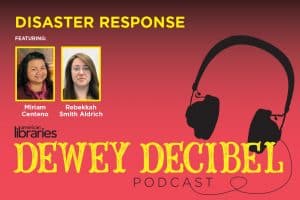
On May 22, 2018, the fire alarm went off in Hale Library, the main library building on Kansas State University’s Manhattan campus.
This wasn’t the first time we’d had fire alarms: leaky pipes, burned bagels, and other incidents had set off our alarms in the past, and the staff was experienced in and accustomed to vacating themselves and others from the building. However, this time was different—smoke was observed and, as first responders came on the scene, it was clear that we had a fire on the roof of the 1927 historic portion of our 550,000-square-foot building.
After several hours, the fire was extinguished, leaving us with a building that had suffered serious water and smoke damage. Several thousands of gallons of water had been poured on the fire and a downdraft of smoke had filled the building, making it unsafe to enter initially. The following morning, we walked into a “new normal” as we worked with university administration and realized the library was going to require a long period of recovery and renovation.
The results of the fire and its aftermath were shocking—standing water, soaked furniture, crumbling ceiling tiles, no power. Very fortunately, our collection had minimal water damage, but every volume in the collection was a victim of “smoke inhalation.”
We worked with Belfor Property Restoration to move 1.5 million items plus special collections and the university archive out of an environment of heat, humidity, and darkness. Items were moved offsite for cleaning and storage until it was safe to come back into the building. Belfor was also responsible for removing all carpet, ceiling tiles, and a large percentage of drywall, essentially tearing the building down to the studs.
During this recovery period, we worked with architects to re-envision Hale Library and seek opportunities among the wreckage. We started with a redesign of the first floor, a project that had already been in the works before the fire, then—floor by floor—we created a new library with the input of staff and the university community.
Renovation started in earnest in January 2019, and a portion of the first floor opened by fall semester to the delight of our students, who were particularly anxious for a place to work and study upon returning to campus. Most of the second floor is expected to open in spring 2020, and the remainder of the five-story building will open by the end the year.
What did we learn from this experience that is beneficial to other libraries, no matter the type or size? Most important: Have a disaster plan, keep it updated, and practice it regularly. We received positive feedback from our university risk-management personnel about how well we handled the immediate evacuation of the building and the recovery process, and that’s because we had a plan that was well known to staff.
Also, I can’t emphasize enough the importance of communication. In the days immediately following the fire, we had to carefully manage active interest from local media. We updated our website and started a blog that continues to provide regular updates on the status of the building, as well as interesting facts and figures about recovery and renovation. Staff—who were now distributed across campus in eight different buildings post-fire—met weekly for several months to keep up to date on the building and future plans.
We also learned subtler lessons, such as the importance of documenting the recovery for both insurance purposes and for our own historical record of the library. We also worked to maintain continuity of operations, particularly interlibrary loan and other services, navigate a complex insurance process, and adapt to managing without access to most of our collections. But we were also provided with new opportunities to fundraise, cross-train staff, and rethink the library’s facilities, services, and collections.
Visit the Hale library blog to follow the progress of our renovation.


